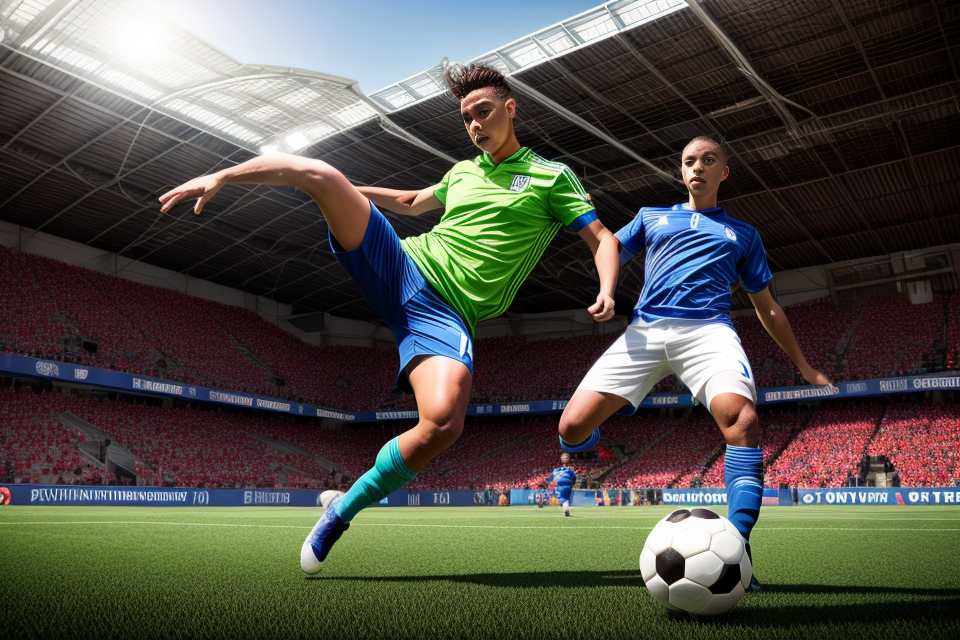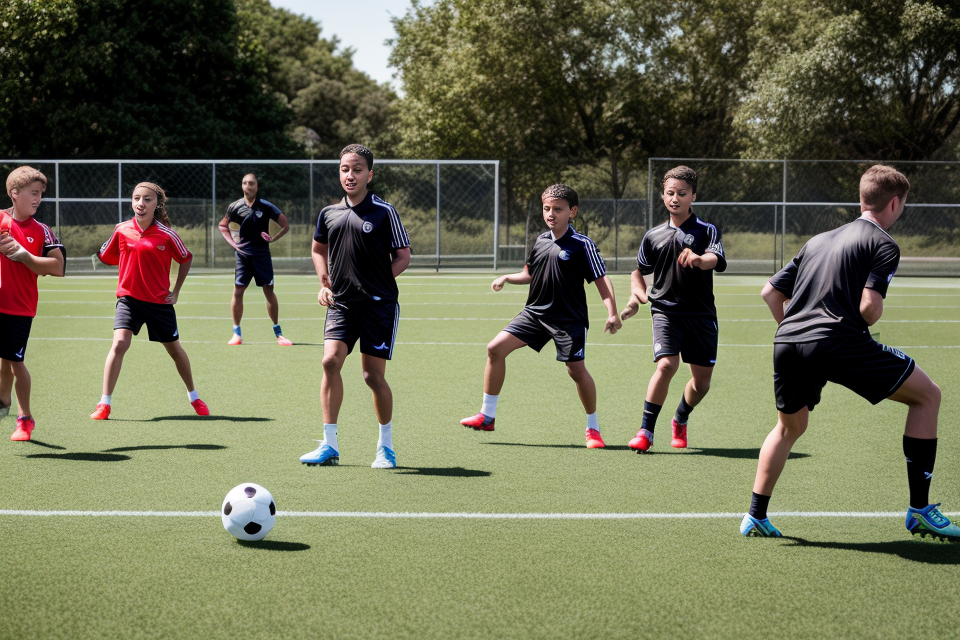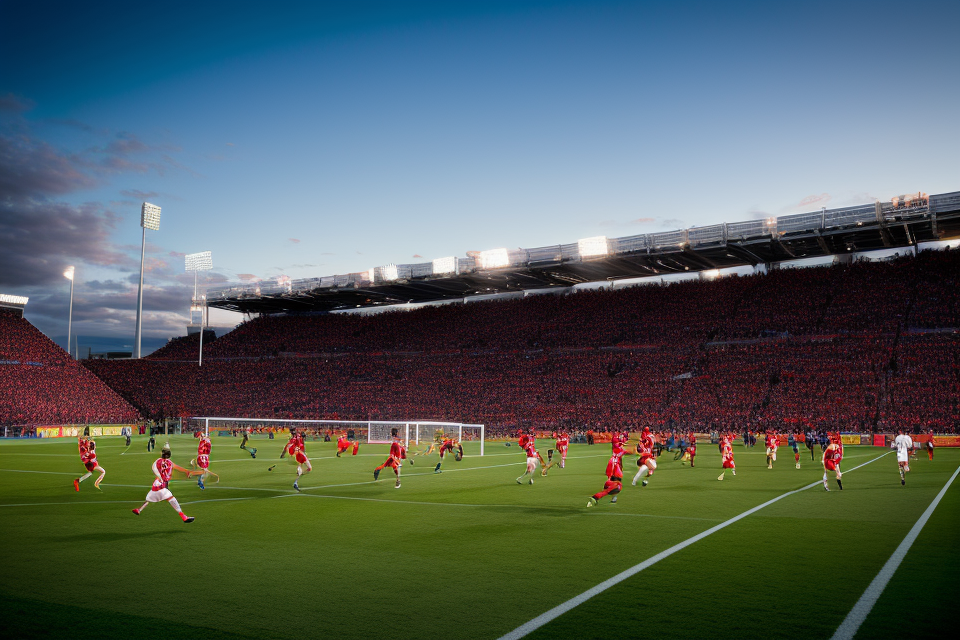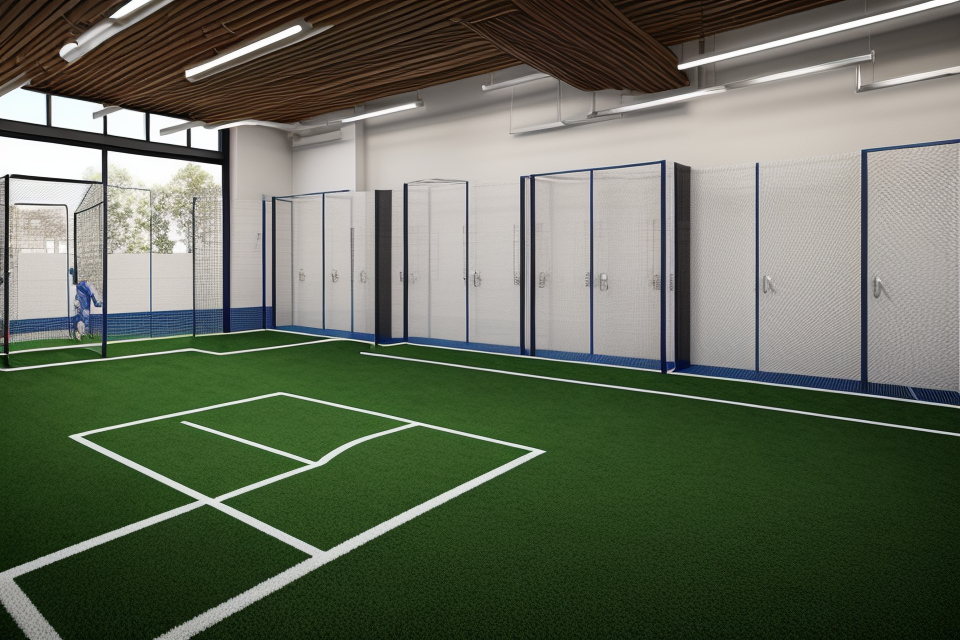Are you looking to improve your soccer skills and become a better player? Look no further! This guide will provide you with practical tips and strategies to help you take your game to the next level. From mastering ball control to developing your shooting skills, we’ll cover all the essential aspects of soccer. So whether you’re a beginner or an experienced player, get ready to learn and improve your soccer abilities.
To improve your soccer skills, the key is to practice regularly and work on specific areas of your game. This can include practicing dribbling, passing, shooting, and ball control. It’s also important to play as many games as possible, as this will give you the opportunity to apply what you’ve learned in a match setting. Additionally, watch professional soccer games and analyze the techniques used by the players. This can give you ideas for new techniques to try and help you improve your own game. Finally, seek out feedback from coaches, teammates, and other experienced players to help you identify areas for improvement and develop a plan for growth.
Setting goals
Identifying strengths and weaknesses
One of the first steps in improving your soccer skills is to identify your strengths and weaknesses. This will help you to focus on areas that need improvement and to develop a plan for achieving your goals. Here are some ways to identify your strengths and weaknesses:
Analyzing your performance
Take some time to reflect on your past performances and identify areas where you excel and areas where you struggle. For example, if you are a fast player but struggle with ball control, you may want to focus on improving your ball control skills.
Seeking feedback from coaches and teammates
It can be helpful to seek feedback from coaches and teammates, as they can provide an outside perspective on your performance. They may be able to identify areas that you may not have noticed yourself and provide suggestions for improvement. Be open to constructive criticism and use it as an opportunity to learn and grow.
Setting SMART goals
Improving your soccer skills requires setting specific, measurable, achievable, relevant, and time-bound goals. This approach is commonly known as SMART goal setting. Let’s take a closer look at each component of the SMART framework:
Specific
When setting soccer goals, it’s crucial to be as specific as possible. Instead of saying “I want to get better at soccer,” outline the specific aspects you want to improve upon. For example, you might aim to enhance your dribbling skills, increase your speed, or develop better ball control. The more detailed your goals, the easier it will be to measure your progress and stay motivated.
Measurable
To track your progress effectively, your goals need to be measurable. This means assigning quantifiable metrics to your objectives. For instance, if you want to improve your speed, you could measure your progress by timing how long it takes you to complete a specific sprint or agility drill. Having concrete metrics will allow you to objectively evaluate your growth and adjust your training regimen as needed.
Achievable
It’s important to set goals that are challenging but achievable. Aiming too high may lead to frustration and demotivation, while setting goals that are too easy won’t push you to grow. To strike the right balance, consider your current skill level and the resources available to you. For example, if you’re a beginner, setting a goal to score a goal in a competitive match might be too ambitious. Instead, you could focus on contributing to your team’s offensive efforts by making key passes or maintaining possession.
Relevant
Your goals should be relevant to your overall soccer development and align with your long-term aspirations. It’s essential to understand what skills and attributes are necessary to excel at the position you play or the type of soccer you enjoy. For instance, if you’re a striker, improving your passing ability might not be the most relevant goal. However, if you’re a midfielder, developing your ball-winning skills could be a more relevant objective.
Time-bound
Setting a deadline for your goals gives you a sense of urgency and helps maintain focus. Without a time frame, it’s easy to put off your objectives indefinitely. To make your goals time-bound, specify when you want to achieve them. For example, you might aim to improve your dribbling skills within the next three months or increase your endurance by the start of the next soccer season. Having a clear deadline will help you stay accountable and committed to your goals.
Developing a training plan
Creating a balanced training program
A well-rounded training program is crucial for soccer players who want to improve their skills. Here are some essential components that should be included in a balanced training program:
- Cardiovascular exercises:
Cardiovascular fitness is a critical aspect of soccer, as it helps players maintain their energy levels throughout the game. Incorporating cardiovascular exercises such as running, cycling, or swimming into your training routine can help improve your endurance and stamina.
- Strength training:
Strength training is essential for building a strong and stable body that can withstand the physical demands of soccer. Players should focus on exercises that target the muscles used in soccer, such as squats, lunges, and leg press.
- Technical drills:
To improve your soccer skills, you need to practice specific techniques such as dribbling, passing, and shooting. Technical drills should be included in your training program to help you develop these skills.
- Small-sided games:
Playing small-sided games is an effective way to improve your soccer skills in a game-like environment. This type of training allows players to practice their techniques and tactics in a controlled setting, while also improving their decision-making and reaction times.
By incorporating these components into your training program, you can create a balanced approach to improving your soccer skills. Remember to vary your training routine and focus on different aspects of the game to ensure all-around improvement.
Periodization
Periodization is a training method that involves breaking down the year into different phases or seasons, each with its own specific goals and training objectives. The three main phases of periodization in soccer training are pre-season, in-season, and off-season.
Pre-season
The pre-season phase typically takes place several weeks before the start of the competitive season. The main objective of this phase is to prepare the player for the upcoming season by building endurance, strength, and overall fitness. This phase should focus on developing a strong foundation of technical skills, such as dribbling, passing, and shooting. Players should also work on developing their tactical awareness and understanding of the game.
In-season
The in-season phase takes place during the competitive season, and the main objective is to maintain the player’s fitness and form throughout the season. This phase should focus on maintaining the player’s technical and tactical abilities, as well as preventing injuries and managing fatigue. This phase may also involve match-specific training, such as working on strategies for specific opponents or game situations.
Off-season
The off-season phase takes place after the competitive season, and the main objective is to rest and recover from the demands of the season while also improving the player’s overall fitness and preparing for the next season. This phase should focus on regeneration and injury prevention, as well as developing new skills and improving weaknesses. Players should also take the opportunity to work on their mental and tactical aspects of the game.
In conclusion, periodization is a crucial aspect of soccer training as it allows players to have a well-structured plan for their development and progression throughout the year. By following a periodized training plan, players can ensure that they are consistently working towards their goals and improving their soccer skills.
Mastering soccer techniques
Ball control
Dribbling
Dribbling is an essential skill in soccer that involves controlling the ball with your feet while moving it up the field. To improve your dribbling skills, practice with a ball in a confined space, such as a small field or a coned area. Focus on keeping the ball close to your feet and using changes of direction to avoid defenders. Practice dribbling with both feet and work on your speed and agility.
Passing
Passing is another important aspect of soccer that involves accurately sending the ball to a teammate. To improve your passing skills, practice with a partner in a variety of situations, such as short passes, long passes, and crossing. Focus on accuracy, weight, and speed of the pass, and aim to use different parts of your foot to control the ball.
Shooting
Shooting is a crucial skill in soccer that involves scoring goals. To improve your shooting skills, practice with a ball in a confined space, such as a small field or a coned area. Focus on getting a good striking technique, using the laces of your foot to curve the ball and the inside of your foot to shoot straight. Practice shooting with both feet and aim to strike the ball with power and accuracy.
By mastering these ball control skills, you can improve your overall soccer performance and help your team score goals.
Defending
To improve your defending skills in soccer, there are several key aspects that you need to focus on. These include positioning, tackling, and marking.
- Positioning: The first step in defending is to be in the right position. This means that you need to anticipate where the ball is going and position yourself in such a way that you can intercept the ball or at least delay the attacker’s progress. Good positioning also involves knowing when to close down the opponent and when to stay back and protect your own goal.
- Tackling: Tackling is an essential skill in defending. It involves making a tackle when the opponent has the ball or is about to gain possession. To make an effective tackle, you need to time it correctly and use the right technique. This means tackling from behind, using the right foot and making contact with the ball, not the opponent. It’s also important to remember that a good tackle is one that stops the opponent from gaining possession without giving away a foul.
- Marking: Marking involves keeping track of the opponent and preventing them from getting the ball. Good marking involves knowing when to pressure the opponent and when to give them space. It also involves knowing when to anticipate a pass and when to stay with the opponent. Effective marking requires good communication with your teammates and a good understanding of the game.
Overall, improving your defending skills in soccer requires practice and patience. By focusing on these key aspects of defending, you can become a better defender and help your team win games.
Attacking
Running with the ball
One of the most important aspects of attacking in soccer is the ability to run with the ball effectively. This involves developing a good first touch, maintaining control of the ball while in motion, and knowing when to pass or shoot. To improve your running with the ball skills, practice dribbling through cones or around obstacles, focusing on keeping the ball close to your feet and using changes of direction to evade defenders. You should also work on your acceleration and deceleration, as these are crucial for gaining separation from opponents and creating space for yourself.
Finishing
Another key aspect of attacking in soccer is the ability to finish accurately and effectively. This involves developing a sense of timing and spacing, as well as being able to place the ball in the back of the net from a variety of angles and distances. To improve your finishing skills, practice one-on-one situations against a goalkeeper or by using a rebounder, focusing on getting shots on target and using different techniques such as laces, instep, or volleys. You should also work on your decision-making in the attacking third, as this will help you choose the best time and place to shoot.
Crossing
Crossing is an important attacking strategy in soccer, as it can create scoring opportunities for your teammates and put pressure on the defense. To improve your crossing skills, practice delivering balls into the box from different angles and distances, using both feet and different types of crosses such as inswinging or outswinging. You should also work on your timing and accuracy, as well as your ability to pick out specific teammates with your crosses. Additionally, practice defending against crosses to develop your awareness and anticipation of where the ball is going and how to defend against it.
Enhancing mental game
Visualization
Visualization is a powerful tool that can help soccer players improve their skills and performance on the field. It involves mentally rehearsing specific scenarios and actions, such as making a crucial save or scoring a goal, to build confidence and enhance physical performance. Here are some tips for incorporating visualization into your soccer training:
- Create a visualization routine: Set aside time each day to visualize yourself performing specific soccer tasks, such as dribbling past defenders or making a successful pass. Make it a consistent part of your training routine so that it becomes a habit.
- Use all your senses: To make your visualization more effective, try to engage all of your senses. Imagine the sounds of the crowd, the feel of the ball at your feet, and the smell of the grass. This can help you feel more immersed in the experience and increase the benefits of visualization.
- Be specific and detailed: The more specific and detailed your visualization, the more effective it will be. Instead of just imagining yourself scoring a goal, imagine the build-up to the goal, the movements of your teammates, and the reaction of the crowd. This can help you mentally rehearse specific scenarios and improve your overall performance.
- Build confidence: Visualization can also be a powerful tool for building confidence on the field. Before a game or important match, take a few minutes to visualize yourself performing at your best. This can help you feel more confident and prepared, which can translate into better performance on the field.
By incorporating visualization into your soccer training, you can enhance your mental game and improve your overall performance on the field. So take some time each day to mentally rehearse your skills and build confidence, and watch as your soccer abilities grow.
Goal setting
When it comes to improving your soccer skills, goal setting is a crucial aspect that should not be overlooked. Setting clear and achievable goals can help you stay motivated and focused on your progress. Here are some tips on how to set effective goals for improving your soccer skills:
- Breaking down long-term goals: It’s important to have a clear vision of where you want to be in the long run. However, it’s equally important to break down those long-term goals into smaller, more manageable objectives. This will help you track your progress and stay on track towards achieving your ultimate goal. For example, if your long-term goal is to become a professional soccer player, your short-term objectives could include improving your speed, agility, and ball control.
- Setting short-term objectives: Short-term objectives are the stepping stones to achieving your long-term goals. They are specific, measurable, and achievable within a short period of time. Examples of short-term objectives include improving your dribbling skills, increasing your endurance, or perfecting your shot. Setting short-term objectives will help you stay focused on your progress and give you a sense of accomplishment as you achieve each one.
It’s important to note that setting goals is not a one-time task. It’s essential to regularly review and adjust your goals as necessary. This will help you stay on track and make any necessary changes to your training regimen. Additionally, it’s important to celebrate your successes along the way, no matter how small they may seem. This will help you stay motivated and encourage you to continue working towards your goals.
Mental toughness
Handling pressure
- Recognize the source of pressure
- Practice deep breathing and visualization techniques
- Focus on the present moment and the task at hand
- Adopt a positive mindset and believe in your abilities
Bouncing back from mistakes
- Take responsibility for your mistakes
- Learn from your mistakes and make adjustments
- Don’t dwell on past mistakes, focus on the present and future
- Stay positive and keep a growth mindset
Staying motivated
Setting realistic expectations
- Progress takes time
- It is important to understand that improving one’s soccer skills is a gradual process that requires patience and persistence. It is not something that can be achieved overnight, and it is important to set realistic expectations for yourself in terms of how much progress you can make in a given period of time.
- It is also important to recognize that setbacks and obstacles are a natural part of the learning process, and that it is okay to not see immediate results. It is important to stay focused on the long-term goal of improving your skills, rather than getting discouraged by short-term setbacks.
- Embrace the process
- Improving your soccer skills is a journey that requires dedication, hard work, and a willingness to learn and grow. It is important to approach the process with a positive attitude and a willingness to embrace the challenges and opportunities that come with it.
- This means being open to feedback and criticism, seeking out new learning opportunities, and embracing the idea that progress is a continuous process that requires ongoing effort and commitment. By embracing the process and staying focused on the journey of improvement, you will be more likely to achieve your goals and reach your full potential as a soccer player.
Celebrating small wins
Recognizing personal achievements
One way to stay motivated when working on improving your soccer skills is to recognize and celebrate your personal achievements. This can include things like making a successful pass, scoring a goal, or successfully completing a drill. By acknowledging these accomplishments, you can help to build your confidence and motivation, which can in turn help you to continue working towards your goals.
Acknowledging improvement
Another important aspect of celebrating small wins is acknowledging the improvements that you have made. This can include things like improving your ball control, becoming more accurate with your shots, or learning how to better anticipate the movements of your teammates. By taking the time to acknowledge these improvements, you can help to reinforce positive behaviors and motivate yourself to continue working hard.
Additionally, celebrating small wins can also involve setting and achieving smaller goals that are more easily attainable. This can help to keep you motivated and focused on your overall goal of improving your soccer skills. By breaking down your larger goal into smaller, more manageable steps, you can help to make progress in a more sustainable and achievable way.
Overall, celebrating small wins is an important aspect of staying motivated when working on improving your soccer skills. By recognizing and acknowledging your personal achievements and improvements, you can help to build your confidence and motivation, which can in turn help you to continue working towards your goals.
Surrounding yourself with positivity
When it comes to improving your soccer skills, one important factor to consider is staying motivated. This means creating an environment around you that encourages and supports your growth as a player. One way to do this is by surrounding yourself with positivity.
Having supportive teammates is crucial when it comes to staying motivated. Your teammates are the people you train with and compete with on a regular basis, so it’s important to have a positive and encouraging atmosphere within the team. This means being supportive of each other’s strengths and weaknesses, and encouraging each other to improve.
In addition to supportive teammates, having encouraging coaches can also make a big difference. A coach who provides positive feedback and constructive criticism can help you stay motivated and focused on your goals. They can also provide guidance and support as you work to improve your skills.
Another important aspect of surrounding yourself with positivity is practicing positive self-talk. This means being kind and supportive to yourself, and focusing on your strengths rather than your weaknesses. By speaking to yourself in a positive and encouraging way, you can help build your confidence and stay motivated to continue improving.
Overall, surrounding yourself with positivity is an important aspect of staying motivated when it comes to improving your soccer skills. By having supportive teammates, encouraging coaches, and practicing positive self-talk, you can create an environment that helps you stay focused and motivated on your goals.
FAQs
1. What are some key soccer skills that I should focus on improving?
Some of the most important soccer skills to focus on include dribbling, passing, shooting, ball control, and agility. These skills are essential for any soccer player and will help you become a more well-rounded player.
2. How can I improve my dribbling skills?
Improving your dribbling skills requires practice and patience. Start by working on your close control, which is the ability to control the ball with different parts of your body. Practice dribbling with both feet and focus on changing direction quickly and efficiently. You can also try dribbling around cones or other obstacles to improve your footwork and control.
3. How can I improve my passing skills?
Improving your passing skills requires practice and a good understanding of the game. Start by practicing different types of passes, such as short passes, long passes, and through-balls. Focus on accuracy and precision when passing, and try to anticipate the movement of your teammates. You can also practice passing in different game-like situations, such as crossing the ball into the box or making a long ball over the top of the defense.
4. How can I improve my shooting skills?
Improving your shooting skills requires practice and a good understanding of the technique. Start by practicing different types of shots, such as inside, laces, and volleys. Focus on the technique of your shot, including your stance, foot placement, and follow-through. You can also practice shooting in different game-like situations, such as one-on-one or shooting from distance.
5. How can I improve my ball control skills?
Improving your ball control skills requires practice and a good understanding of the technique. Start by practicing different types of ball control, such as juggling, crossovers, and ball rolls. Focus on your first touch and the way you control the ball when it’s coming to you. You can also practice ball control in different game-like situations, such as receiving a pass or controlling a long ball.
6. How can I improve my agility and speed?
Improving your agility and speed requires a combination of physical training and practice on the field. Start by working on your cardiovascular fitness through running and interval training. You can also practice agility drills, such as ladder drills and cone dribbling, to improve your footwork and reaction time. Additionally, practice sprinting and quick changes of direction to improve your speed and agility on the field.



